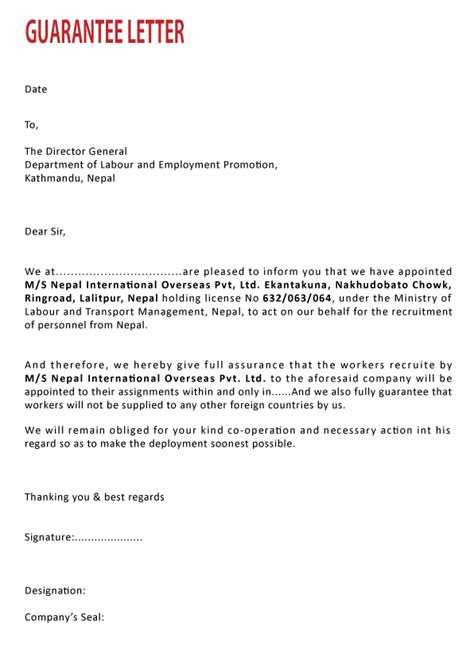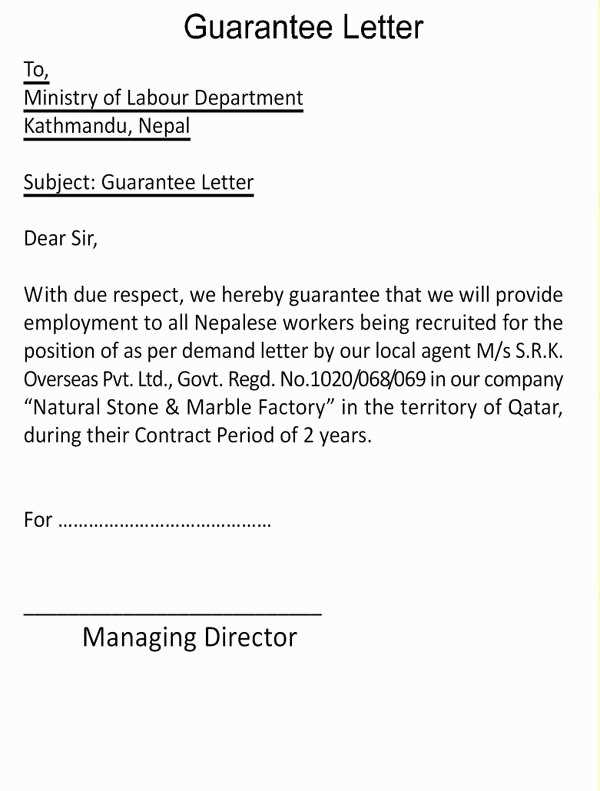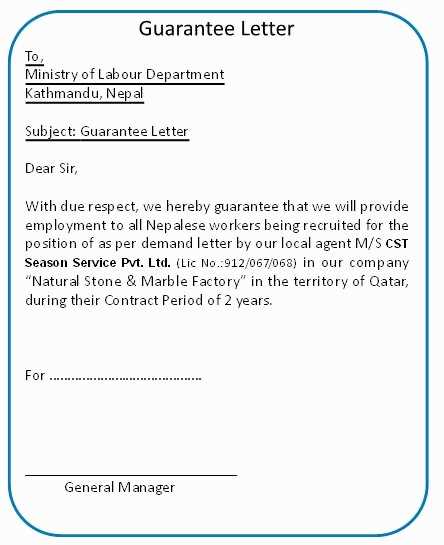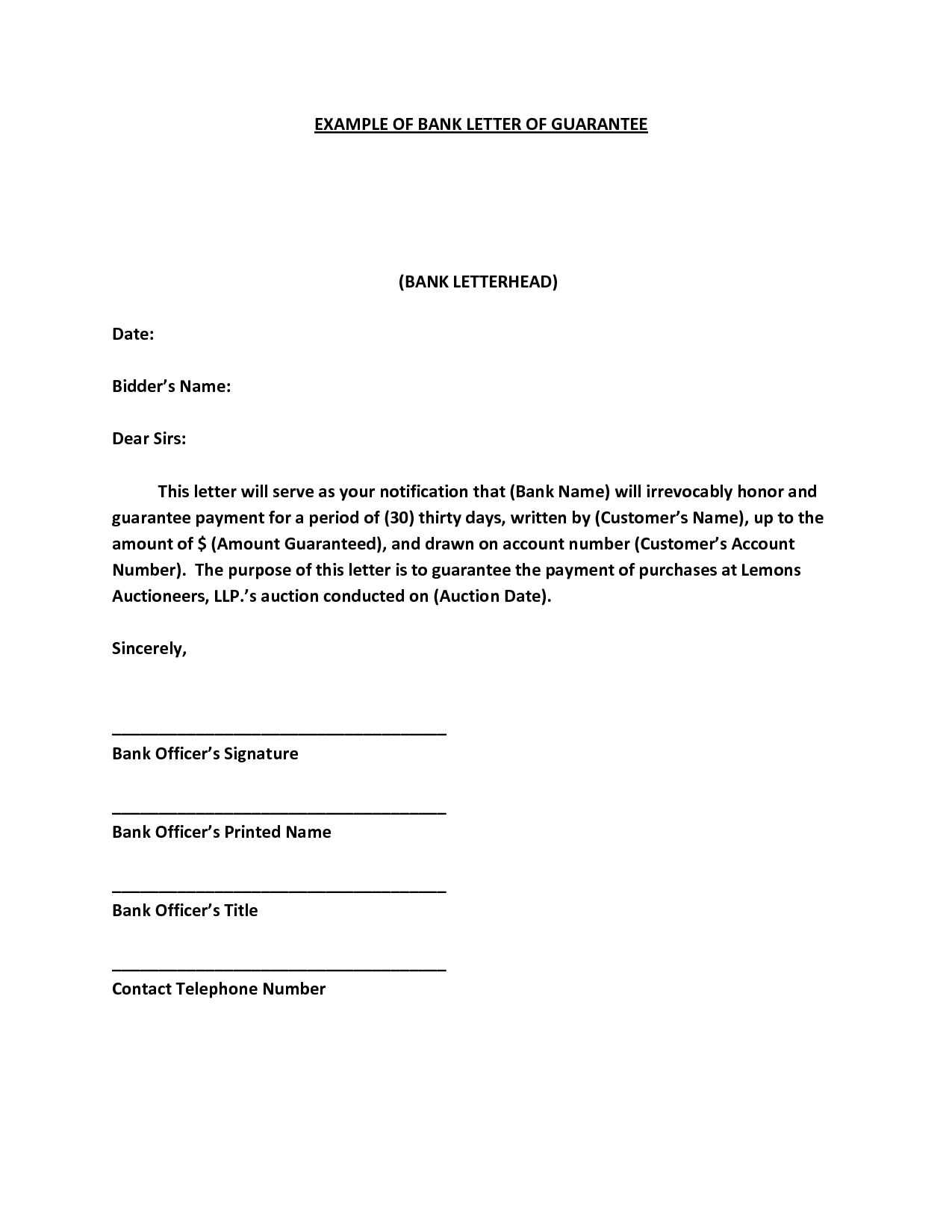How to Create a Guarantee Letter Template

In business and personal matters, it is essential to have a formal commitment that outlines specific promises or obligations. Such a document serves to establish clear expectations between parties involved in an agreement, ensuring that all terms are understood and adhered to. Whether for financial transactions, service agreements, or product warranties, having a written record provides security and peace of mind for all parties.
To create an effective document, it must contain the necessary components that specify the scope of the promise, the responsibilities of each party, and the consequences in case of non-fulfillment. Clarity and precision are key to making the document legally binding and enforceable. This process involves understanding the appropriate language and structure to ensure its validity and reliability.
In the following sections, we will explore how to craft a well-structured document, the legal considerations to keep in mind, and common mistakes to avoid in order to ensure the document holds weight in any situation. By following these guidelines, you can create a strong and dependable agreement that safeguards both parties’ interests.
Understanding the Purpose of a Guarantee
When entering into agreements, it is crucial to have a formal assurance in place that outlines specific commitments and the responsibilities of each party. This assurance serves as a safety net, ensuring that both sides fulfill their obligations and protecting against potential risks. It provides a clear framework that helps prevent misunderstandings and provides legal security in case of disputes.
Such a commitment is particularly important in business transactions, where large sums of money or important services are involved. It creates a formalized bond that guarantees a party will take responsibility if the other fails to meet the agreed terms. This form of protection fosters trust and promotes smoother interactions between individuals or companies.
When to Use a Guarantee Letter
In various situations, it is necessary to formalize a commitment that assures one party will meet certain obligations or cover any potential losses. This is especially true in business, where the value of transactions or services demands additional security. When a person or company is unsure about fulfilling their part of the deal, such a document provides the necessary protection for both sides.
Business Transactions and Agreements
In commercial settings, especially with large financial transactions, having a written commitment is crucial. It provides the other party with assurance that their interests are protected in case something goes wrong. Whether it’s a service contract or a loan agreement, having formalized protection strengthens trust and encourages smooth operations.
Personal and Financial Obligations
In personal matters, such as renting an apartment or making a large purchase, individuals may require assurance that the terms of the agreement will be followed. A well-crafted commitment document can serve as a safeguard, especially when dealing with parties who may not have an established relationship or history of trust.
Essential Components of the Document
A well-structured document must include several key elements to ensure its effectiveness and legal standing. Each part plays a vital role in defining the expectations and obligations of all parties involved. Without these crucial components, the document may lack the necessary clarity or enforceability.
Identification of Parties is the first essential element. Clearly stating the names and roles of the involved parties helps to avoid confusion and establishes who is responsible for fulfilling the terms. Next, a clear description of the terms should be provided. This outlines the exact obligations, duties, or services promised and what is expected from each side.
Another important section is duration and conditions. The time frame for which the commitment is valid and any conditions that must be met during that period must be outlined. Additionally, specifying consequences for non-fulfillment ensures there are clear guidelines on what happens if the terms are not met, offering security to the parties involved. Lastly, signatures and dates are crucial for confirming the agreement’s validity, ensuring that both sides acknowledge the document’s contents and are legally bound by it.
Step-by-Step Guide to Writing One
Creating a formal assurance document requires careful planning and attention to detail. By following a clear, structured approach, you can ensure that the document covers all necessary aspects and is legally sound. This guide breaks down the process into simple steps, so you can confidently write a binding commitment that protects all parties involved.
Step 1: Start with a Title
The first step in drafting the document is to give it a clear title that reflects the nature of the commitment. This title should be concise and informative, indicating the purpose of the agreement.
Step 2: Identify the Parties Involved
Make sure to list all parties involved in the agreement. Include full names and their roles to avoid confusion. This establishes the individuals or organizations that will be responsible for fulfilling the terms.
Step 3: Detail the Terms and Conditions
Clearly describe the specific obligations, duties, or services that are promised. Specify any important conditions that must be met to ensure the agreement is honored.
| Section | Description |
|---|---|
| Parties | List the names and roles of involved individuals or organizations. |
| Obligations | Outline the specific promises or actions that must be taken. |
| Conditions | State any requirements or circumstances that apply to the agreement. |
Step 4: Define the Duration and Terms
Set the time frame for which the commitment is valid, along with any renewal or expiration terms. Make sure to include the duration and any specific events that may trigger changes to the agreement.
Step 5: Specify Consequences for Non-Compliance
Clearly state what will happen if the conditions of the agreement are not met. This ensures that there is a mutual understanding of the repercussions for failing to fulfill the terms.
Step 6: Finalize with Signatures
Conclude the document by including spaces for both parties to sign and date the document. This confirms that both parties acknowledge the terms and agree to be legally bound by them.
Common Legal Issues with Guarantees

When drafting or entering into formal commitments, several legal complications can arise. These issues may affect the enforceability of the agreement and can lead to disputes or unexpected liabilities. Understanding these potential challenges can help both parties mitigate risks and ensure the document serves its intended purpose without legal ambiguity.
Ambiguity in Terms and Conditions

A common issue arises when the terms outlined in the commitment are unclear or too vague. If the obligations or conditions are not precisely defined, it can lead to differing interpretations by the involved parties. This uncertainty can cause disputes, particularly if one party feels the other has not fulfilled their obligations as expected. It is crucial to be specific and detailed to avoid confusion in the future.
Lack of Legal Capacity

Another potential problem is the involvement of a party who lacks the legal capacity to enter into the commitment. This can include individuals who are underage, mentally incapacitated, or entities acting beyond their authority. If a party does not have the proper legal standing, the agreement may be deemed void or unenforceable, potentially leaving one side unprotected.
Tips for Ensuring a Strong Agreement
Creating a solid and effective formal document requires careful attention to detail and consideration of various factors. To ensure that the agreement is clear, enforceable, and protects all parties involved, follow these essential tips when drafting or reviewing the terms.
- Be Clear and Precise: Avoid vague language and ensure that all terms are clearly defined. Specificity helps prevent misunderstandings and disputes.
- Include All Relevant Parties: Ensure that all individuals or entities involved in the agreement are properly identified with their roles and responsibilities clearly outlined.
- Understand the Legal Implications: Be aware of the legal requirements and implications of the commitment, including any potential consequences for non-compliance.
- Set Realistic Expectations: Make sure the obligations set in the document are achievable for all parties and consider potential obstacles that could arise.
- Seek Professional Advice: If necessary, consult a lawyer or legal expert to review the document and ensure that it complies with relevant laws and regulations.
By following these tips, you can create a document that is not only effective but also stands up to scrutiny, ensuring that all involved parties are protected and that the terms are clear and enforceable.